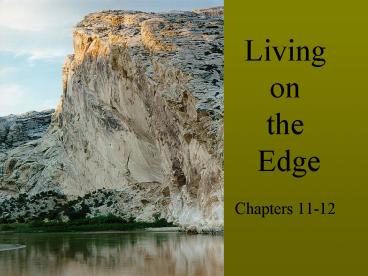Living on the Edge Chapters 11-12 - PowerPoint PPT Presentation
1 / 24
Title:
Living on the Edge Chapters 11-12
Description:
key com.apple.print.PageFormat.PMHorizontalRes /key dict ... key com.apple.print.ticket.modDate /key date 2005-11-07T15:52:42Z /date ... – PowerPoint PPT presentation
Number of Views:17
Avg rating:3.0/5.0
Title: Living on the Edge Chapters 11-12
1
Living on the EdgeChapters 11-12
2
Between the Tides
3
Life on the Edge
- Weve all lived on
- the edge once in
- a while, or at
- least wanted too.
- As we will see in the next two chapters, living
on the edge isnt always bad, but isnt always
good either. - Animals near the edge (ANNEs) must endure a hard
life. - Well focus on edge effect in marine communities.
4
Its likely you wouldnt want to even visit
here, let alone live in this place, right?
This is technically part of the intertidal zone,
an area of shoreline between the high and low
tide marks.
5
This is more like itAnimals basking in the sun,
right? Not really, these Periwinkles
(Littorina cicta) are battling for survival at
low tide. They hold fast to cracks and crevices
to retain moisture until tide waters
return. Emersion time or time spent out of the
water, becomes more and more of an issue the
higher in the intertidal zone you get.
6
Even when youve think youve got it made, you
still risk dessication, or drying out as these
chitons (Sypharochiton pelliserpentis) have
discovered. Other hazzards, include extreme
salinity changes, pH imbalances, temperature
spikes, and predation.
7
If you have a Spring Tide, one with a large
range, then you mightfind yourself waiting a
long time before water returns to your resting
spot. Alage often dries out.In contrast, Neap
Tides, short range, are much friendlier on some
organims.like these mussels (Mytilus
californianus)!
8
ANNEs survive in other ways too. Coloration is
certainly beneficial when you dont want to be
scorched! The ridges in this snail,
(Nerita plicata) look nice, but also serve to
cool the animal.
9
Nice waves, eh? Intertidal zones are constantly
churning and bubbling. As a result many sessile
organism rely on filter feeding and not deposit
feeding.
10
It looks pristine, but wave action is one of the
chief concerns of ANNE. As waves approach
shore, wave action moves animals in all
directions. As a result they hold on any way
they can.
11
Figure 11.09
12
Some are underachievers on surpose! Height
exposes you to more wave action and can
littorally rip you from house and home.
ooohthat was bad.
13
Others, like this sea anemone, Anthopleura
xanthogrammica, grow tall in light tidal action,
yet grown short and wider when in the rough
seas.
This limits the forces they must endure. Keeping
your feet is a matter of using hold fast
(seaweeds) and byssal threads (mussels).
14
Being flexible is an option as well.
15
Lets not forget that even in the midst of chaos
ismore chaos!! Food webs, prey and predation
still apply when your fighting for your life.
16
Figure 11.21
17
Real estate is a hot commodity near the
edge. mussels, barnacles, sea limpets, and
anemones all compete for space. Often growing
right over top other their neighbor in an attempt
to crush the competition. Competetive exclusion
yet again rears its ugly head!
18
(No Transcript)
19
(No Transcript)
20
In an intertidal zone, keystone species are very
important to community structure.
21
Figure 11.23
22
Figure 11.24
23
(No Transcript)
24
(No Transcript)






![[PDF READ ONLINE] Business on the Edge: How to Turn a Profit and Improve Lives in the Worl PowerPoint PPT Presentation](https://s3.amazonaws.com/images.powershow.com/10099606.th0.jpg?_=20240815052)
























